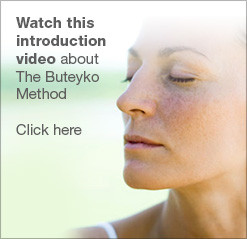Breathtaking news
By Cathy Babao Guballa
Philippine Daily Inquirer, Lifestyle, May 01, 2001
ASTHMA is no joking matter. Parents of asthmatic children go through hell each time a child experiences an attack. The summer months are particularly difficult – the deadly combination of heat and smog certainly have a deleterious effect on the health of these children.
In the Philippines for a series of lectures on the Buteyko Method of Breathing Reconditioning is Jac Vidgen, an Australian, senior Buteyko practitioner who promises to bring relief and breath of hope to those suffering from asthma and other related disorders. Vidgen has been involved with the Buteyko method for the past seven years. Previously based in Sydney, he did regular workshops there as well as in New South Wales. He is the first practitioner to bring the method to Southeast Asia. He has been featured on the CNN morning show in Asia and trained by Alexander Stalmatski, a leading prot*g* of Dr. Buteyko. Vidgen however is quick to say that the method is not easy and requires commitment and dedication. To those who are willing to commit, he promises great improvement in health.
“Breathing is the most basic thing we do everyday.” Vidgen begins to tell us. How much should we breathe? A normal person, Vidgen says, takes 20,000-30,000 breaths per day. Most people think that “the more breaths, the better”. Vidgen says this is a misconception and any examination of the physiology of respiration indicates that this concept is quite misleading – even dangerous.
Beginnings of Buteyko
The treatment was developed in the 1950s in Russia by a Russian medical doctor and scientist, Dr. Konstantin Pavlovich Buteyko. Dr. Buteyko made some clinical observations and discoveries, which revealed that human breathing habits, seem to have strayed from what our physiology books describe as normal. What he identified as increasingly prevalent in modern society, is low level (and mostly hidden) hyperventilation, which he discovered is a major underlying cause of human illness. Buteyko further noticed that by reducing this overbreathing to more normal respiratory volume levels, a whole range of diseases and their symptoms improved. He then developed a program for enabling patients to retrain their breathing pattern, which has evolved into the Buteyko technique.
Stress, asthma and Buteyko
Stress is a well-known stimulant for hyperventilation. As a response to stress the heart rate increases, breathing deepens and hormone production changes.
Vidgen says that during most of the period of evolution of the human body, stress occurred simultaneously with physical activity for which these responses were quite appropriate. “When our ancestors were startled by the proverbial lion, their respiration would increase. Doing so would rid them of carbon dioxide which made room for the rapid build-up during the subsequent effort at escaping the lion.” Vidgen explains,”The stress then was short-lived. If you weren’t eaten by the lion, you would escape and your stress would disappear.”
Nowadays however, most of the stress occurs while our bodies are at rest – in which case the above responses become quite inappropriate. In prolonged periods of stress, deeper breathing becomes an unrecognized, unconscious and continuous habit and physiological pattern. Once the body becomes conditioned to the lower levels of carbon dioxide, the respiratory mechanism drives a person to breathe more than he needs to, thus keeping the levels low.
Vidgen further explains that with low levels of carbon dioxide, the body’s smooth muscle tissue can go into spasm or constriction, creating problems in the sinus passages, lungs, arteries, heart and digestive system. When hyperventilation is triggered to increase air, the lungs of an asthma sufferer react with constriction of airways, excess mucus production and swelling – as in the symptoms of asthma.
How Buteyko works
In the same way that lingering stress sustains hyperventilation long enough for the respiratory center to adapt to lower levels of carbon dioxide, so too Buteyko therapy works by breathing over a long time. Under the program, patients learn to recognize their own overbreathing pattern and how to retrain their breathing to normal levels. A range of adverse symptoms are reversed, and relief from asthma and many other conditions follow. The following benefits are typically observed:
- Recovery of nasal breathing. This allows for effective filtration, humidification, regulation of temperature and airflow, as well as reduction of allergen entry.
- For asthmatics, relief of acute bronchospasm through the bronchodilatory properties of carbon dioxide, leading rapidly to a reduction in the need for bronchodilators; then reconditioning of the automatic breathing pattern and avoidance of bronchospasm with continued practice and application of Buteyko’s methods.
- Reduction of excess mucus
- Improvement in a range of other conditions such as allergies, rhinitis, sinusitis, anxiety disorders, apnea, snoring and emphysema
- Improvement in quality of sleep
- Increased energy levels and enhanced sports performance
Vidgen says the manner of teaching is varied depending on the individual’s age, history, condition and response. Some lifestyle modifications involving posture, nutrition, sleep and exercise are recommended to enhance the benefits of the breathing exercises. Workshops are taught in five-to-two-hour sessions and class size is kept to a minimum of 5-15 participants. Patients are supplied with notes and support materials during the workshops to include diaries for recording of exercise results, pulse variations, symptoms, medication, reports of sleep length and quality and energy levels. Vidgen concludes by saying that changing unconscious breathing patterns requires much discipline, perseverance and persistence but the results and benefits gained from such dedication is truly, as the song goes, worth every breath one takes.
